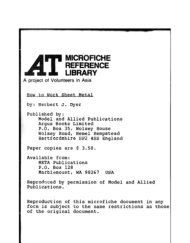Create successful ePaper yourself
Turn your PDF publications into a flip-book with our unique Google optimized e-Paper software.
3<br />
. .<br />
.<br />
-7<br />
7<br />
good browns as well as yellows and some<br />
greens. Rhododendron in the higher alti-<br />
tudes and X~g~oli~ grmtdiflora ‘of the<br />
co,astal regions will produce good gray<br />
colors if the foliage is cooked with rop-<br />
peras in an iron pot.<br />
‘I’hca red stems of rhubarb, with oxalic<br />
l!lGl! and tin, give lavender as do the<br />
“tlowers” - ( brncts) of the subtropic gar-<br />
tlrri. fa\-oritr, poinsettia. Piglveed (~h~)lo-<br />
jwffiiinz ulhyri ), fl very obnoxious w~ccl of<br />
\vastr placrs, roadsides and railway em-<br />
bankments, givM a superb nit233 grren<br />
\I-ith nllun ancl (sopper or iron. Tl1.e fruits<br />
01’ all xptJc.irs of sIl11l~c (Rhus), cooked<br />
u itI1 ~.opper;is in an iron pot, also give<br />
oritstanilin~g .Florida and one of theta,<br />
0. compressa, has a listed range as far<br />
north as Sdntucket Island 011 the<br />
northeastern Eoast. :5<br />
* The high tannin of npny of the oaks<br />
(Quercz~) and hemlock (Tsuga) may be<br />
used with iroG >sulfqte for a variety of<br />
grays and Macks. If other pigments are<br />
$resent: tans *and browns=of great perma-<br />
,<br />
i<br />
_<br />
.<br />
Pokeweed<br />
nence result. Black oak (f&e&us velu-<br />
tkz), known as the source of the dyestuff<br />
quercitron, has a range extending<br />
throughLnt .the East and as far south as<br />
Georgia. LIlthougll the bark as a dyestuff<br />
is well documented, it is insufficiently<br />
known by today’s dyers.. It is S. year-<br />
round source of yellow& and yell.ow-<br />
orange colors. Southern bayberries. (My:-’<br />
ica spp.) equal their northern counter-,<br />
parts; sassafras, native to both areas, is<br />
famous for its pinky tans.<br />
’ Cochineal<br />
The Opwntia cacti are frequently infested,with<br />
conspicuous white mats of the<br />
scale-covered bodies of the females of<br />
o the insect Dqctylopius COCCUS, cochineal.<br />
\Yhen eibough are gathered all the reds,<br />
purples and okanges known for cochineal<br />
(see also page 57) may be had. Small<br />
quantities yield good intensity dyebaths ”<br />
for limited amounts of wool. Even a weak.<br />
bath may be used more than once because<br />
it is, the character of the pigments to be<br />
L<br />
entirely depleted from the bath, given 4..<br />
enough time and mordant. The regular “\ :’<br />
cochineal recipes apply.<br />
.:<br />
The wide geogrdphic range of the<br />
South with its touches of’qubtropic flora I<br />
and a wealth of species offers the aye? an .<br />
inexhaustible supply of plants from<br />
which&es maS be produced. A multitude ,.<br />
of species remain to be sampled for their<br />
dyebp&enFial.. + a :<br />
WASH.,1 oz. wool in a good soapsuds, then rinse and simmgr it for 1 hour in<br />
5’2 gallon of water to which has been added ‘/2 cup vinegar. Remove the wool<br />
but do not rinse. Now add 2 quarts of ripe berries from pokeweed (Phy!olacca<br />
‘americanal to the vinegar, water and add another l/2 cup of vinegar. Boil<br />
about 30 iinutez. Strain 6nd add enofigh wdter to make ~‘/2 gillon. Add<br />
the wool and simmer l/2 -1 hbur, ,dependi,ng on the shade desired. At no time<br />
allow the wool to“boil. Keep’ the bath $8 the simmering stage and the wooI<br />
constantly pressed down,,under the wat6r. Hang the w’ool to dry. In the next<br />
day or two rinse the wool thorbughly.until the’water”is clear. This dye is.,not<br />
fast to sunlight .-Palmy Weigle ’<br />
0<br />
_’ 9<br />
r i<br />
22<br />
-I<br />
‘4<br />
I t<br />
. Q<br />
\<br />
Y







